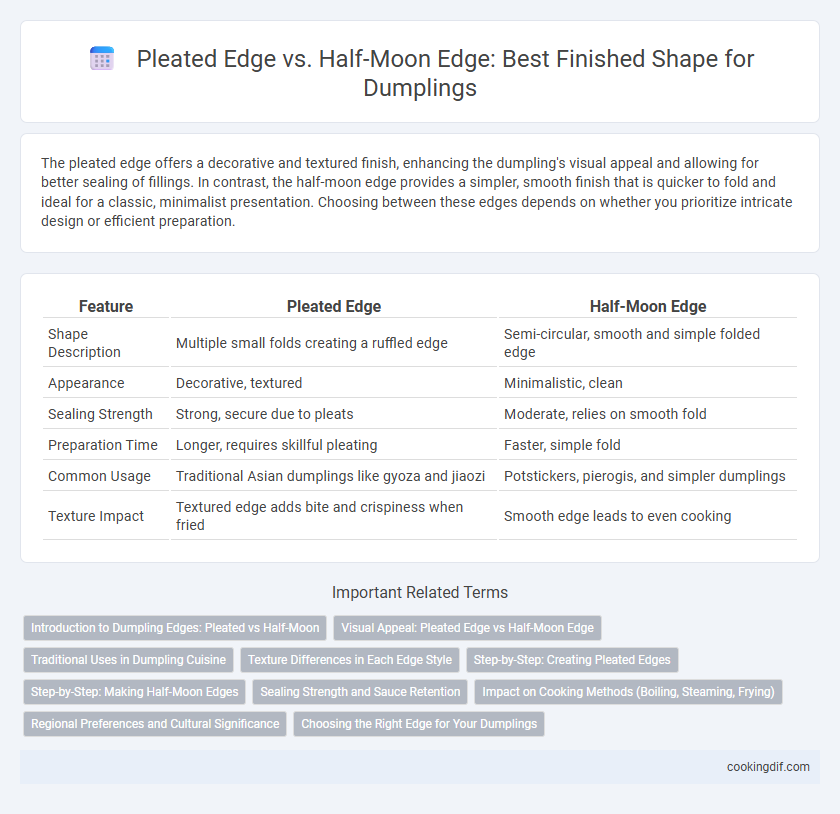The pleated edge offers a decorative and textured finish, enhancing the dumpling's visual appeal and allowing for better sealing of fillings. In contrast, the half-moon edge provides a simpler, smooth finish that is quicker to fold and ideal for a classic, minimalist presentation. Choosing between these edges depends on whether you prioritize intricate design or efficient preparation.
Table of Comparison
| Feature | Pleated Edge | Half-Moon Edge |
|---|---|---|
| Shape Description | Multiple small folds creating a ruffled edge | Semi-circular, smooth and simple folded edge |
| Appearance | Decorative, textured | Minimalistic, clean |
| Sealing Strength | Strong, secure due to pleats | Moderate, relies on smooth fold |
| Preparation Time | Longer, requires skillful pleating | Faster, simple fold |
| Common Usage | Traditional Asian dumplings like gyoza and jiaozi | Potstickers, pierogis, and simpler dumplings |
| Texture Impact | Textured edge adds bite and crispiness when fried | Smooth edge leads to even cooking |
Introduction to Dumpling Edges: Pleated vs Half-Moon
Dumpling edges play a crucial role in defining their texture and appearance, with pleated edges featuring intricate folds that create a decorative, layered look while enhancing grip and structural integrity during cooking. Half-moon edges, formed by simply folding the dough over the filling and sealing with a smooth curve, provide a clean, minimalist finish ideal for steaming or boiling. Both pleated and half-moon edges influence the dumpling's cooking method and visual appeal, catering to different culinary traditions and preferences.
Visual Appeal: Pleated Edge vs Half-Moon Edge
The pleated edge offers a visually intricate and traditional appearance, characterized by multiple folds that create texture and depth, enhancing the dumpling's handmade aesthetic. In contrast, the half-moon edge provides a smooth, minimalist look with a clean, streamlined silhouette, often perceived as modern and elegant. Visual appeal depends on the context: pleated edges emphasize craftsmanship and detail, while half-moon edges highlight simplicity and uniformity.
Traditional Uses in Dumpling Cuisine
Pleated edges are commonly used in Chinese dumplings such as jiaozi, where the detailed folds help create a sealed and textured finish that holds juicy fillings securely during boiling or steaming. Half-moon edges are popular in Japanese gyoza and Korean mandu, providing a simpler, smooth seal that crisps nicely when pan-fried. Traditional cuisine often dictates the edge style to complement cooking methods and regional flavor profiles, making the pleated edge ideal for softer, steamed dumplings and the half-moon edge suited to more crispy, pan-fried varieties.
Texture Differences in Each Edge Style
Pleated edges on dumplings create a textured, ridged surface that crisps and holds sauces better, enhancing the eating experience with a satisfying bite. Half-moon edges offer a smooth, simple finish that results in a tender, uniform texture, ideal for steaming or boiling. The choice between pleated and half-moon edges significantly affects mouthfeel and presentation, influencing overall dumpling texture and sauce retention.
Step-by-Step: Creating Pleated Edges
Creating pleated edges involves folding the dumpling wrapper in a series of small, overlapping pleats along one side, securing the filling inside while adding texture and visual appeal. Start by placing a small amount of filling in the center of the wrapper, then fold one edge slightly over the other, pinching to create the first pleat. Continue making evenly spaced pleats along the edge until the dumpling is fully sealed, resulting in a distinctive, ridged pattern compared to the smooth, simpler half-moon edge.
Step-by-Step: Making Half-Moon Edges
Making half-moon edges for dumplings involves folding a circular wrapper in half to create a smooth, crescent shape, which enhances even cooking and a streamlined appearance. Begin by placing the filling in the center, then carefully fold the wrapper over, pressing out any air before sealing the edges firmly with your fingers or a fork to prevent leakage. This method contrasts with pleated edges, offering a simpler, faster technique that produces a clean finish favored in many Asian dumpling recipes.
Sealing Strength and Sauce Retention
Pleated edge dumplings provide superior sealing strength due to multiple folds that securely lock the filling, reducing the risk of leakage during cooking. This edge style creates small ridges that help trap and hold sauce better than the half-moon edge. Half-moon edges offer a smoother finish but generally have weaker seals and less surface texture, resulting in reduced sauce retention and increased vulnerability to bursting.
Impact on Cooking Methods (Boiling, Steaming, Frying)
Pleated edges create a thicker seal that holds up well during boiling, preventing dumpling filling from leaking into the water and maintaining shape in steaming. Half-moon edges provide a smoother, tighter closure that crisps evenly during frying, enhancing texture without compromising structural integrity. Choosing pleated edges suits methods involving more moisture, while half-moon edges optimize frying results by promoting even browning and a delicate crunch.
Regional Preferences and Cultural Significance
Pleated edges are commonly associated with Chinese dumplings like jiaozi, symbolizing skillful craftsmanship and regional pride in northern China. Half-moon edges, often seen in Japanese gyoza and Korean mandu, reflect streamlined folding techniques suited for pan-frying and steaming, emphasizing simplicity and practicality. These distinct shapes not only influence cooking styles but also carry cultural significance that highlights regional culinary traditions and symbolic meanings.
Choosing the Right Edge for Your Dumplings
Choosing the right edge for your dumplings depends on the desired texture and sealing method; pleated edges provide a decorative and tight seal ideal for steaming, while half-moon edges offer a simpler, rustic look suitable for pan-frying or boiling. Pleating requires skill but enhances the dumpling's aesthetic appeal and helps prevent filling leakage. Half-moon edges are quicker to shape and create a uniform cook, making them practical for large batches or casual meals.
Pleated edge vs Half-moon edge for finished shape Infographic

 cookingdif.com
cookingdif.com